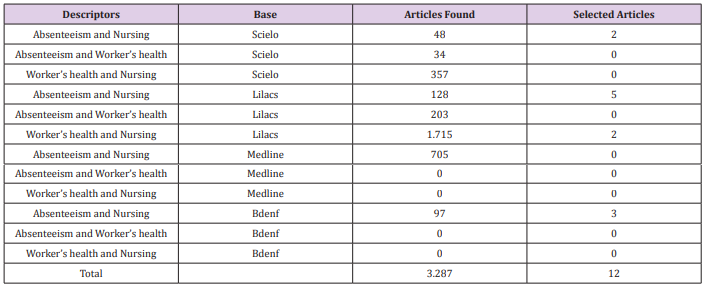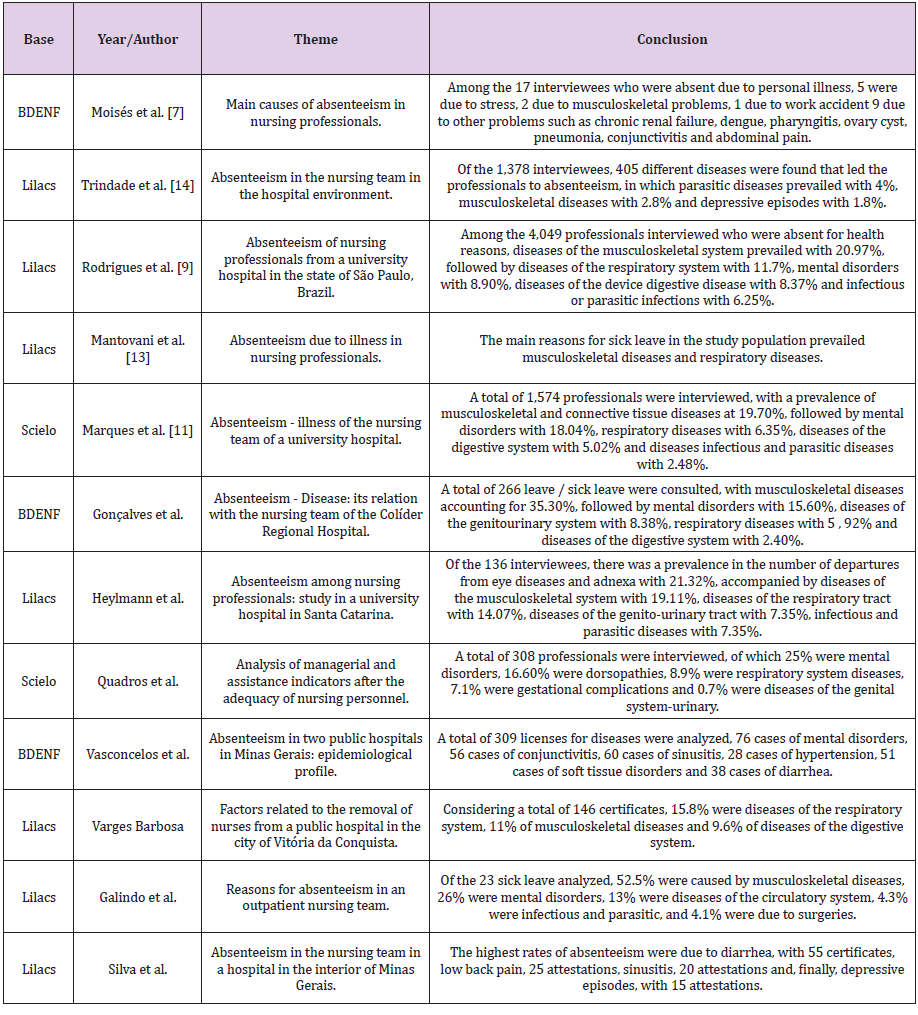The Main Causes of Absenteeism Disease Among Nursing Professionals - An Integrative Literature Review
Introduction
Nursing plays a fundamental role in the various health sectors, since it is the professional category with the highest number of professionals working in this field. Faced with this scenario, there are many problems encountered in this field due to the labor demands that arise but are not adequately addressed. The most frequently encountered problems are the overload of work and the work shift in the work schedule, as well as the inadequacy of the nursing staff, which are the major risk factors for the health of the professional and also for patient safety [1]. In the hospital, the nursing team suffers the most from the unhealthy environment. All of these factors contribute to job failure [2]. These absences at work are translated by absenteeism, a word of French origin (absenteeism) which means lack of attendance at work. Absenteeism is an expression used to denote the worker’s absence from work activities not motivated by unemployment, prolonged illness or legal leave [3]. The absenteeism is the frequency or duration of work time lost when professionals do not attend work and absences correspond when they are expected to be present. Misconduct leave of absence for participation in training and development programs, among others, constitute absences [4].
Absenteeism is classified into five types: absenteeism-illness (absence justified by health leave); absenteeism due to professional pathology (occupational accidents and/or occupational disease); legal absenteeism (supported by laws such as gestation, disgust, gala, blood donation and military service); compulsory absenteeism (suspension imposed by the employer, imprisonment or other impediment to attend work); and voluntary absenteeism (unjustified private reasons) [5]. Faced with this classification, the absenteeism due to illness, which refers to removal from medical certificates, is the main cause of non-programmed work absences, reaching 71 to 81% of the total. These high levels of absenteeism are disruptive and bring major losses, for example, the annual cost of absenteeism to the UK national economy was estimated at about £1.5 billion in 2013. In Brazil, a nursing worker from a single hospital in São Paulo in 2008 showed that absenteeism-illness cost the employer equivalent to R$389.817,76 referring to the 2,538 days of absences in a year. These financial charges cause damage to the service and to the workers, be it in the economic, operational, physical and mental order, with decreasing productivity, cost increases, job dissatisfaction and overloading of other health workers [6].
The nursing is the profession that suffers most from illness, being more subject to the effects of stress than other professions. Because of this, there is growing concern on the part of government agencies and researchers about the working conditions of health professionals, especially nursing, since both the working conditions and the environment in which it is exercised, in general, does not always provide effective safety for workers. Among these nursing professionals, absenteeism should receive special attention due to the characteristics of the work and to directly influence the quality of care provided [7]. Through this, since the 1930s, the International Labor Organization (ILO), together with the World Health Organization (WHO), work with studies that have identified the precarious situation of the work of nursing professionals. The focus of these studies has been the unsatisfactory conditions of nursing work, due to long hours of work, absence of rest periods, on Sundays and holidays without fair compensation, and lack of participation in planning and decision-making in relation to nursing. professional practice, teaching and working conditions [8]. Faced with this problematic that surrounds the difficult working conditions of nursing professionals, and justifies our choice for this subject, it becomes imperative to understand what are the main diseases that are compromising the health of these workers and that are resulting in increased absenteeism. Whereas, emphasizing the results found, it will enable the search for solutions that will improve the quality of life and health of these professionals.
Objective
To carry out a survey, within the literature, of the main diseases listed in the articles, which compromised the health of nursing workers, leading them to absenteeism.
Method
Integrative literature review. For the bibliographic survey, the electronic databases were used: Nursing Database (BDENF), Latin American and Caribbean Literature in Health Sciences (LILACS), Medical Literature Analysis and Retrieval System Online (MEDLINE) and virtual health library Scientific Electronic Libary On Line (Scielo).Three descriptors were defined: Absenteeism, Nursing and Worker Health, associated with the Boolean operator “AND”. The research was carried out in the first and second semester of 2018, obeying the inclusion criteria: articles published in Portuguese between 2013 and 2018; available in the databases consulted and in full text. The exclusion criteria adopted were: bibliographic review articles; editorials; abstracts, dissertations and theses.
Result
(Table 1) shows the descriptors used, databases, number of articles found and articles selected, according to an integrative review of the literature. And (Chart 1) presents the articles in relation to the base, year, author, theme and conclusion. After analyzing the 12 articles selected to be part of this study, the diseases that most caused absenteeism among the nursing team were raised in relation to the number of sick leave, as shown in Table 2.
Table 1: Relation of the association of the descriptors used, databases, number of articles found and articles selected.
Table 2: Relation between the main diseases that caused absenteeism and the number of sick leave in the nursing team.
Discussion
Based on the results found, it was verified that in the 12 articles that were part of this study, there were a total of 6,557 medical licenses per disease. According to the data in Table 2, diseases of the musculoskeletal system and tissues were the ones that caused the most absenteeism by disease with 25.96% of the licenses, followed by mental disorders such as depression and stress that presented 14.72%, diseases of the respiratory system with infectious and parasitic diseases with 6.86%, diseases of the digestive system with 6.85%, ocular diseases and attachments with 6.02%, lesions and poisonings with 5.73%, diseases of the genito- complications during pregnancy, delivery and puerperium with 1.92%, neoplasms with the same 1.92%, diseases of the circulatory system with 4%, diseases of the nervous system with 2.44% skin and subcutaneous tissue with 1.48%, diseases of the auricular apparatus with 0.29%, work accident with 0.11% and other diseases that were not pointed out by the works researched corresponded to 2.75%. The group of musculoskeletal diseases was the main cause of absenteeism, according to the survey, corresponding to about a quarter of all licenses. These data reveal physical overload and unsatisfactory ergonomic conditions in the performance of the work.
The nursing team, during the work activities, helps the patient move in and out of the bed. As coworkers move away, there is overhead for others in a situation of continuous demand. Inadequate posture is another aggravating factor, which is associated with psychic load. In addition, the incidence of complaints has a greater impact on women, due not only to the biological characteristics of women, but also to the unequal division of sex at work today. Other causes are associated with overtime, work pace and working conditions [9]. Besides that, the musculoskeletal disorders are the most common cause of withdrawal. In a study cited by him, it was shown that 80 to 93% of the occurrences of musculoskeletal disorders are associated with the nursing work conditions in the hospital setting. The regions most affected were the cervical, shoulders and knees, the lumbar region being the most evident [10]. Mental disorders such as depression and stress were the second major cause of absenteeism. The nursing professional coexists constantly with pain, suffering and death. These conditions can lead you to develop psychiatric illness. With regard to the relationship between stress and work, it is observed that the human being is faced with a professional universe that often makes demands beyond its capacity in contemporary society. This fact generates a constant state of stress among the workers. It is the stress of occupational character.
Illnesses arise when an individual’s ability to respond to work in a healthy way is exhausted. Stress is recognized as one of the most serious risks to the individual’s psychosocial well-being [11]. The work environment, too is a social variable, can be an important source of mental suffering. Workplace factors, related to the health-disease process, include noise, inadequate lighting, temperature extremes, vibration, aesthetics, hygiene and care. As factors related to work organization, overload or underload of physical and mental work; participation and involvement in work; interpersonal relationships at work; work pace and time pressure; making it impossible for functional ascension, due to the lack of implementation of job and salary plans [12]. Respiratory system diseases are the third major cause of absenteeism in the study. Respiratory diseases can be caused by the risk of aspiration of chemical and biological elements present in the work environment, or related to influenza, pneumonia or other respiratory disease. In addition, the team is susceptible and is constantly in contact with patients with diseases transmitted by droplets and aerosols and are not always diagnosed immediately [13]. That infectious and parasitic diseases, including bacterial food poisoning, infectious diarrhea and gastroenteritis, are considered to be preventable pathologies.
These may be associated with professional burnout, which undermines self-care. In most cases the onset of symptoms and the development of the disease are related to the ingestion of food or water contaminated with pathogenic microorganisms and /or their toxins. The occurrence of these pathologies suggests the fragility in hand hygiene among professionals, which increase the risks to their health and the health users under their care [14]. In relation to diseases of the digestive system, cardiovascular diseases, located in this study as diseases of the circulatory system, neoplasms and diseases related to low immunity, the nursing profession requires day and night work professionals in their work, which is characterized as an aggravating factor in the development of these diseases. In addition, the nursing profession allows more than one job to be accumulated; in some cases, workers accumulate up to three employment links [10]. That because of this intense working day, professionals have a greater habit of eating pre-cooked, frozen foods and also pinching. Some companies also do not care about the quality of the menu served, especially at night, including even feijoada for this population. With this, the complaints of the workers of heartburn, abdominal pains, constipation, are frequent, being able to aggravate and to arrive at cases of chronic gastritis or ulcers. Poor diet may favor the onset of digestive, cardiovascular, coronary and certain types of neoplasms [15].
Conclusion
Coming to the conclusion of this study, it can be concluded that the main diseases that led to absenteeism among nursing professionals were, according to the researched literature, musculoskeletal diseases, followed by mental disorders, diseases of the respiratory system, infectious and parasitic diseases and diseases of the digestive system. This survey confirmed that nursing staff, due to their work overload, long working hours, physical and mental exhaustion are contributing negatively to the incidence of these diseases and leading to absenteeism, especially in the number of medical licenses for musculoskeletal disorders and mental disorders.
More BJSTR Articles: https://biomedres01.blogspot.com/





No comments:
Post a Comment
Note: Only a member of this blog may post a comment.